
| Takashi Tachibana Visiting Professor of the Research Center for Advanced Science and Technology, University of Tokyo |

| Takashi Tachibana Visiting Professor of the Research Center for Advanced Science and Technology, University of Tokyo |
Since I am not a researcher working at the forefront of computer science, I would like to discuss the significance of the Real World Computing Project from a somewhat different standpoint. My academic background is philosophy. From a philosophical point of view, this particular project raises a question, "What is the real world to human beings?" Today, I would like to develop my discussion from such a viewpoint.
In December 1996, I visited the Tsukuba Research Laboratory of RWCP. At that time, I had opportunities to see research results similar to those that will be demonstrated at this symposium, to have discussions with researchers, and to read some papers. I had had some exposure to the Real World Computing Project through the mass media, but the tour provided me a first chance to see and touch the specific results of the project. Though it was a hurried visit, I found that the most advanced computer science has already reached a very interesting level. I don't mean, "interesting" in the sense that computer specialists would refer to this science, but rather in a broader meaning that captures the fact that even outsiders like me can be inspired to think about the philosophical aspects of these scientific developments.
To begin with, I would like to discuss the position of the RWC Project in the broader context of artificial intelligence and other research activities. A magazine called "Kikai Shinko" (Machine Promotion), gave extra space for stories on the Real World Computing Project. The September 1995 issue of this periodical, for example, had a special feature article entitled, "13 Years of the Fifth Generation Computer Project" (Fig. 1); it was very interesting. Real World Computing is also referred to as the "Sixth Generation Computer," and the project is regarded as the successor to the Fifth Generation Computer Project. Definitely, the RWC Project has many characteristics supporting the position that it is the successor to the Fifth Generation Computing Project, but it also has its own unique features.
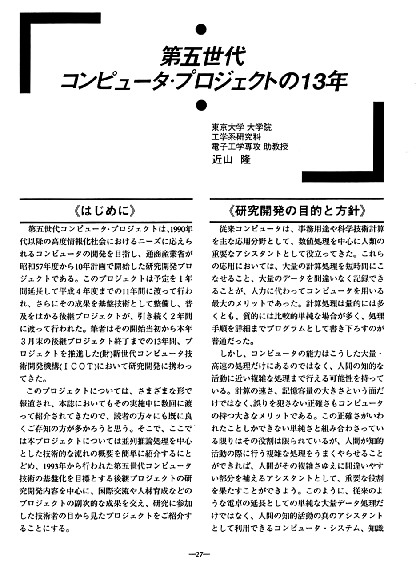
Fig. 1
I think those of you who are about my age can still remember the Fifth Generation Computing Project's advance publicity which was done on a grand scale. From it, we had the impression that a visionary world of artificial intelligence was just around the corner. When the project was completed some 13 years later, the results were not as impressive as the advance publicity had promised. I recently had a talk with Mr. Bill Gates, of Microsoft, for a magazine article; we happened to discuss the Fifth Generation computer. He scathingly denounced the project, saying that the Fifth Generation computer was a complete failure.
His remark was partly true. The key concepts of the Fifth Generation Computer Project can be summed by the words, "parallel" and "inference." The project purposed to develop an entirely new computing technology based on these two new ideas. The project actually did have some specific successes, and did developed some dedicated machines, including the PIM (parallel inference machine) and the Multi-PSI. Also, the project created a programming language, an operating system, and some applications for the hardware. However, the Fifth Generation computers were experimental and were equipped with many features and capabilities without any real regard for cost performance. As a result, the machines lost out due to market competitiveness. Then, the project decided to open the software to others, free of charge. But even if researchers could get this software, they could not buy a computer that could operate the programs. Therefore, in the end, the only use for those programs was as reading material to be appreciated as great intellectual achievements by interested researchers. No wonder that the project was not highly evaluated.
In fact, the Fifth Generation Computer Project had many achievements. In particular, it provided us the opportunity to catch up with other advanced countries, since Japanese computer science had been far behind the rest of the advanced countries prior to the advent of that project. Another valuable result was that many talented researchers came out of the project. Based on these outcomes, the Sixth Generation Computer Project could be established.
As stated above, the Fifth Generation Computer Project had many positive factors as well as negative ones. Reflecting on that project, it can be concluded that the advance publicity was so excessive that people were forced to expect too much from it. Probably to avoid repeating that chain of events, I found that very little information on specific projected outcomes of the Sixth Generation Computer Project have been broadcast through the mass media.
The Sixth Generation Computer Project was not designed to produce one outstanding achievement and then proudly announce it by saying "We've made it!" Rather, it is planned to develop various element technologies so as to set a conceptual direction for future computer technology. Hopefully, therefore, people will appreciate that this is a project developed on a steady plan to gradually advance in a certain direction while achieving certain objectives on the way.
Publicity for the Real World Computing Project is much too limited. Even though I had heard of the name, I really didn't understand what the Real World Computing Project was all about until I visited the Tsukuba Research Center. After my visit to the Center and having had a chance to hear of a number of demonstrations and presentations that were later scheduled for this symposium, I felt that outstanding elemental technologies were actually taking shape in this project. Discussing in detail each specific outcome of the Real World Computing Project would take a considerable amount of time. And in any case, since I'm not capable of handling a detailed discussion of computer science, I will not discuss the matter that way. I did feel, however, that some tasks previously believed impossible to perform on computers are becoming possible at a relatively fast pace. Examples of such research include "information integration,"and a multimodal man-machine interface which can deal with human speech and gestures. Another research activity in progress is designed to implement "episode memory," which is one of several memory systems in the human brain, in computers. Also among other interesting sub-projects were the study of an autonomous learning system and the development of a self-organizing database. Learning a little bit about all these efforts gave me the impression that a variety of challenges are steadily being pursued.
I think that the basic direction of this project can be summed up in two key concepts. The first is "flexible information processing," (Fig. 2) and the second is "real world" (Fig. 3). So far, computers have been handling only the abstract or logical world. The real world has been kept outside of the scope of computer technology. Enabling computers to step into the real world requires "flexible information processing" technologies. The RWC Project is founded on this basic concept. After seeing some of the intermediate outcomes, I am convinced that the basic policy of the project is absolutely right. Considering the current status of RWCP efforts, I must admit there is still a long way to go before achieving all of the final research objectives. Yet, the researchers are moving toward their ultimate goals step by step.
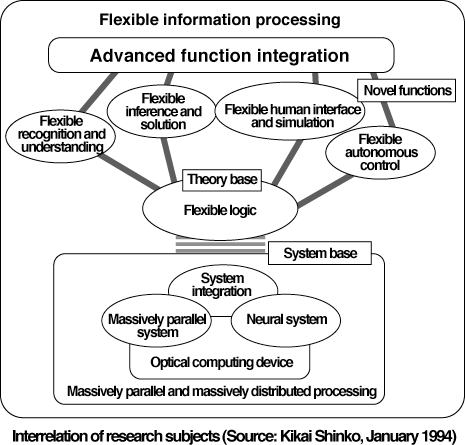
Fig. 2
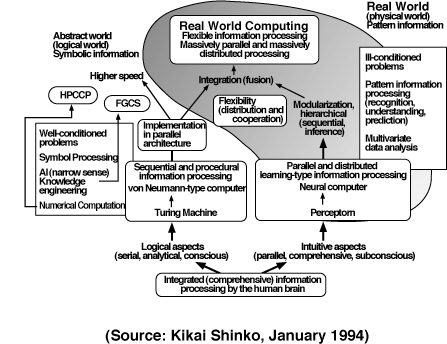
Fig. 3
Obviously, the next question must be; "What will the computer world be like, or how will it develop if it keeps advancing along the RWC Project's basic policy". When you hear of flexible information processing, and of a computer capable of handling the real world much like a human brain, you will probably be reminded of "HAL 9000," the computer which appeared in the movie "2001: A Space Odyssey." Looking back from my present point of view, HAL 9000 was a quite interesting computer. I re-read the movie scenario and novel yesterday, and realized again that computer was a great achievement, although it was only a movie character.
I would like to briefly review the historical background which led to the advent of HAL 9000 and the history of artificial intelligence research up to the birth of the Real World Computing Project.
Looking over the past few decades, it is obvious that the research of artificial intelligence started several years before this chronicle (Fig. 4).
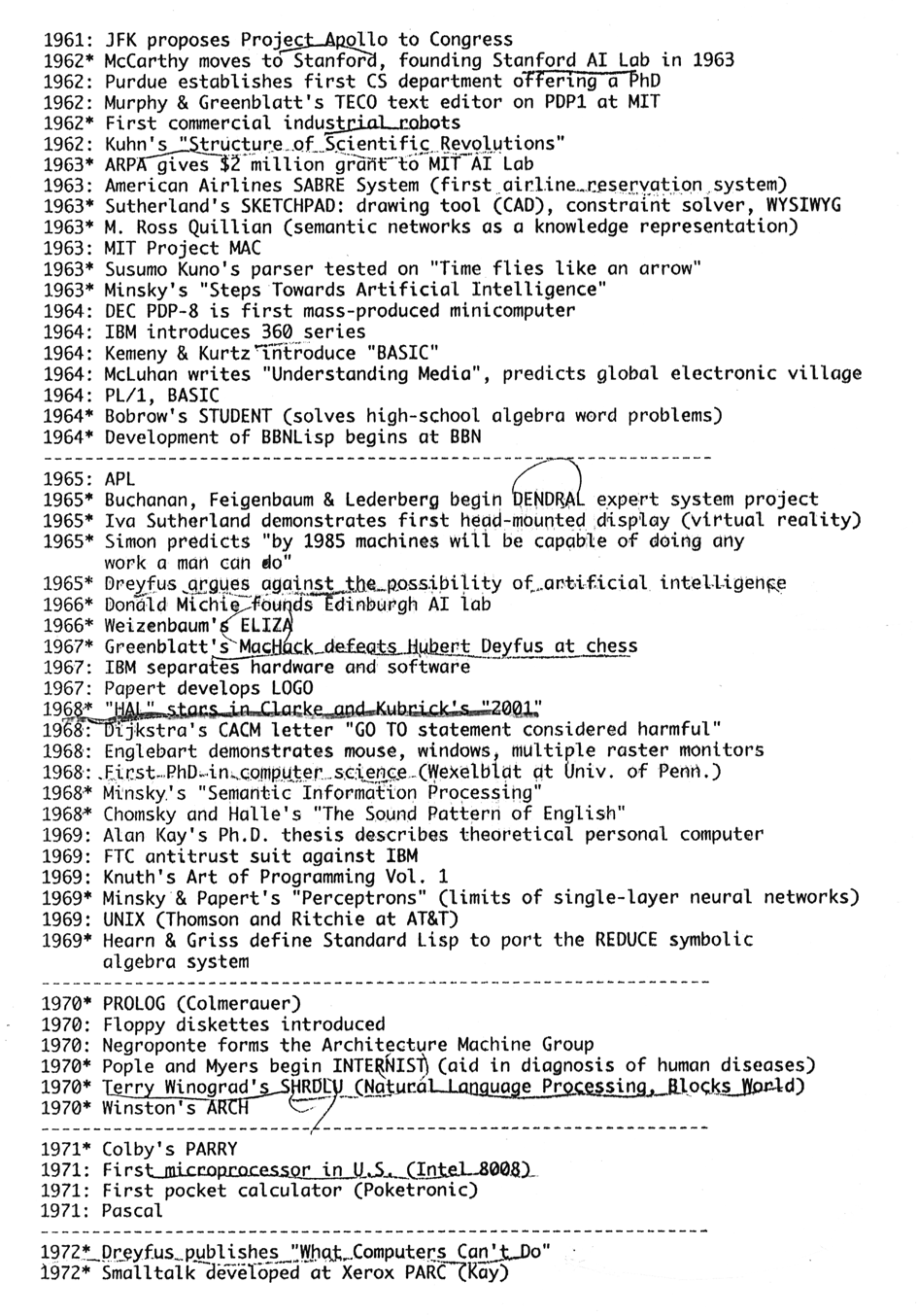
This figure shows a well-organized timetable of artificial intelligence research available at the Carnegie-Mellon University Web site. The research of artificial intelligence actually started at the Dartmouth Conference in 1956.
In 1957, Herbert A. Simon developed GPS (General Problem Solver). At that time, Simon made a number of prophecies. In 1957, he predicted that an artificial intelligence system would defeat a human chess champion within 10 years. Also, he prophesied that a computer would discover a very important mathematical theorem within another decade. And in the following decade, that all psychological propositions would be translated into computer programs.
However, his prophecies hardly came true within the time frame he set. Only his prediction about an artificial intelligence system winning a chess championship was partly coming true some 30 years later when IBM's supercomputer "Deep Blue" won a game against the world chess champion in 1996. As for the discovery of a mathematical theorem, computers were used towards this aim for a certain period of time but, basically, could not find any particular theorems.
I found a very interesting passage in this chronicle which says "Dreyfus argues against the possibility of artificial intelligence." Hubert Dreyfus was also a very strong amateur chess player, and was beaten by an artificial computer at chess. He was chagrined at his defeat and wrote a book entitled "What Computers Can't Do" in 1972. This book was recently translated into Japanese and is selling well. Since he was defeated by a computer at chess, Dreyfus has been consistently critical about the possibility of artificial intelligence.
Looking back at the 1960s, we can see historically that artificial intelligence systems were invented one after another. Very famous systems like DENDRAL and SHRDLU were developed during that decade, and proved to be successful at the demonstration level. Especially SHRDLU, which was able to handle a natural language, although on a limited scale.
Many other accomplishments were made during the 1960s. The Apollo program started in the late 1950s and succeeded in landing men on the moon in 1969. An enormous amount of money was invested into the development of computer technology in an attempt to carry out the Apollo program, consequently, a number of technological achievements were made.
In 1968, HAL 9000's birth year, almost every researcher was optimistic about the future of artificial intelligence development, partly because some significant AI projects had succeeded. I think that many researchers believed at that time that a super-intelligent computer like HAL 9000 would be developed by the year 2001.
In time, we were to enter the period christened the "winter of artificial intelligence" in the 1980s. What was the very beginning of the winter for AI? The beginning was marked by the publication of an article entitled "AI: A Revolution Begins," which appeared in Business Week in 1983.
The milestones listed in the chronicle that I've just shown were all laboratory-level or experimental systems with a limited spectrum of subject areas. Strangely enough, however, people turned their attention to AI systems and thought that artificial intelligence could be used for industrial applications. As it was expected that AI systems would provide many benefits, a huge amount of investment was made into the development of artificial intelligence during the period from 1984 to 1986. I believe some 50 million dollars were invested towards AI purposes. The investment was, however, a failure. At that time, almost every AI system was effective only in the "toy world." Although it was quite natural that people in industrial fields wanted to use AI systems, not one of the actual developments to date worked, which disappointed the users. This is a possible scenario for how the "winter of artificial intelligence" began.
Researchers had remarkable achievements in the small "toy world" with their AI systems, including SHRDLU. However, once they tried to expand the scope of their systems to include the real world, they faced great difficulties in many facets of their development efforts. Hubert Dreyfus attacked AI systems on just these grounds. The facts were that the real world could not be readily comprehended or assimulated by artificial intelligence research at that time.
For example, expert systems were successful only at the experimental level, since researchers followed procedures exactly as previous specialists had done. These researchers tried to load a wide range of expertise into expert systems in order to put them into practical use. However, this so-called transfer of human knowledge to expert systems became a big problem. Even people who possessed specific knowledge could not accurately express their knowledge in real terms. Researchers had difficulty in even representing or describing knowledge.
Furthermore, computers could not accomplish even basic activities, such as feature extraction and pattern recognition, which are very simple and easy for the normal human brain. For instance, when you tried to advance the methodology used in SHRDLU in order to process natural languages, the inherent complexity rapidly grew larger. Therefore, it was impossible to build a system which could effectively describe and process such complexity in a well-organized manner. In short, the problem evolved around the question of scalability. Because of this, systems which were successful at an experimental level could not be developed into a practical system.
In those days, research into artificial intelligence, brain science, and cognitive science, were all rapidly evolving as they partly overlapped and supplemented one another (Fig. 5).
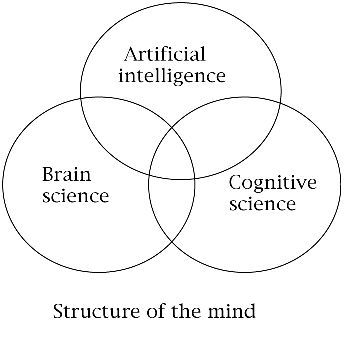
When optimism was at a high level about the future of artificial intelligence, people coincidentally expected much of brain science research as well. Some optimistically viewed that all basic aspects of the brain would soon be clarified, at least in terms of information processing. This optimism for brain science worked as a supportive background and influenced people in the AI field. Consequently, interested persons positively anticipated that AI research would be advanced by the impending evolution of brain science. In other words, optimism existed behind another optimism; it was like multi-layered optimism. During the "winter of AI" in the 1980s, researchers of brain science also encountered terribly big problems at very fundamental levels and their struggles still continue.
Cognitive science derives from a branch of psychology. This new scientific area is rapidly growing, further stimulated by the ongoing evolution of artificial intelligence and brain science research, and is establishing itself as a new branch of science. Cognitive science will uncover untapped knowledge bases, which will, in turn, prompt advancements in the other two areas. This situation looks to continue for the time being.
In conclusion, whenever we discuss the future of computer science, how these three fields develop in cooperation with each other will be of utmost importance.
Beside the support from other scientific areas, the advancement of computer
hardware and software is most decisive to the research of artificial
intelligence.
I found this chart (Fig. 6) in Hans Moravec's book entitled
"Mind Children." The right vertical line indicates the cost, in US dollars, of
hardware which can match human capabilities. With this chart, you can determine
how much it will cost if you want to have hardware with the same capability as a
human being. For example, 1012 (ten to the twelfth power) is $1,000,000,000,000
(one trillion dollars). No one can afford such a ridiculously expensive machine.
What this chart tells us is how radically the cost of hardware is decreasing, as well as how radically the performance of hardware is improving. In general, you will find a continuing trend of hardware decreasing in cost and improving in performance. According to this chart, a personal computer with abilities as good as that of the human brain will be available at $1,000; almost 100,000 yen is predicted around 2030.
The left vertical line shows the computation ability per unit cost (bit/sec, 1988 prices). The rapid increase in the computation ability per unit cost will positively influence the radical advancement of hardware. As a matter of fact, computer hardware is dramatically evolving at a steady pace.
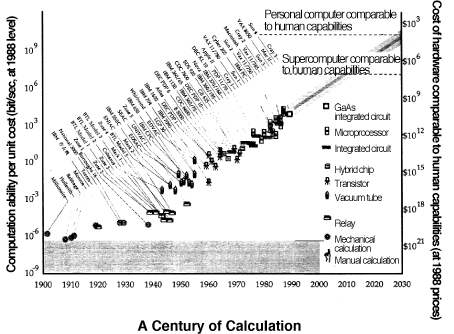
Fig. 6
However, in the area of microprocessors, we are gradually getting closer to the limits of manufacturing technology. Conventionally, a single CPU is used for sequential processing. The next step will be the extensive use of multiple CPUs for parallel processing, one of the Fifth Generation Computer Project's outcomes, which is becoming popular even in smaller computers. The problem is that even after parallel architecture is implemented, computers are still evolving in a linear fashion.
An idea we cannot afford to overlook in the development of computer technology is the use of genetic algorithms to improve the functionality of computers. Genetic algorithms are already utilized in certain "evolving" processes.
Recently I have been meeting with some researchers who are engaged in research on computer evolution using genetic algorithms. I find this is a very interesting and promising technological area.
I understand that several researchers are trying to improve computers through the use of these genetic algorithms within the framework of the Real World Computing Project. In the natural world, the cumulative intelligence of humanity came about as a result of biological evolution. It continued to evolve and has finally reached its present height. If this evolutionary process can be employed to artificial intelligence, it will be possible to enhance artificial intelligence to a higher level. The ultimate implementation of this; evolvable hardware (EHW), or hardware which can evolve, has been invented (Fig. 7).

Fig. 7
When I heard of EHW for the first time, I thought it was a joke. Most people would think that it would be impossible for hardware to evolve in any sense of the word. However, it really is becoming technologically possible to support the evolution of hardware.
One possible way to do this is through the integration of a field programmable gate array (FPGA) and random access memory (RAM). By running genetic algorithms on the FPGA/RAM, programs in RAM can be evolved. When you overwrite old programs with the evolved ones, hardware will actually evolve accordingly. Actually, research has now reached a level higher than the FPGA/RAM method. In this newest method, a portion of the hardware which evolves, and another part which makes use of the latest hardware evolution, will be implemented in a single chip. The chip itself will evolve by changing internal connecting routes. This is the forefront of hardware evolution research.
You'll find researchers working on this subject at the Electrotechnical Laboratory, a cooperative organization for the RWC Project, and at the Advanced Telecommunication Research Institute (ATR) in western Japan.
In the United States, other researchers are working on this type of research at the Massachusetts Institute of Technology (MIT). I was really surprised to find out that they had already reached a technology level where such self-evolving chips have been developed. Chips will continuously evolve and may create an incredible computer at last. I really believe that something magnificent is taking shape right now.
Then what will come next? Driven by the evolution of hardware, and the enhancement of computer power, magnificent advancements can already be seen in this RWC Project. For example, one of the research projects is geared towards transplanting conscious functions into a snake robot (Fig. 8).
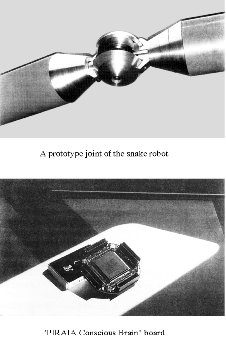
Fig. 8
Common sense has told us that computers cannot have consciousness. Well, the definition of consciousness is still being disputed. If we can give a computer some kind of consciousness, such a machine will be able to process information at a higher level than previously capable. Actual research activities have started advancing in this direction.
So far, computers or machines with consciousness have existed only in the SF world; realms of fantasy which could allow a HAL 9000 to exist. A "consciousness chip," although still far from a conscious computer, has actually been developed. So, let's stop for a moment and face the question, "What is consciousness?"
The book "Mind Children," by Hans Moravec, a robotic researcher at Carnegie-Mellon University, discusses the type of consciousness that machines may have. This book also mentions the book "Animal Minds," by Griffin. This very famous piece of writing was recently translated into Japanese. There are big differences between Eastern and Western ways of thinking. Generally, people have a clear distinction between animals and human beings in the West. It is a kind of taboo for Westerners to talk about the consciousness of animals. Griffin's "Animal Minds," however, argues that we have to consider animal consciousness. Animal behavior can easily be understood if you employ the notion of "consciousness." As Moravec wrote, "No matter how immature it is, consciousness is a model which allows us to think about behavior options or internal models of yourself, the environment, and other individuals." "An internal model of the world which is complex enough to enable the selection of behavior - whether or not you call it "consciousness" - is what robotic specialists are now trying to give their mobile robots." This model is based on exactly the same principle as the "consciousness chip" of the RWC Project.
The definition of consciousness is one of the biggest questions in the field of brain science too. Its meaning draws all sorts of opinions and a variety of models. This is a mind model created by Professor Masao Ito, a winner of the Order of Cultural Merit (Fig. 9).
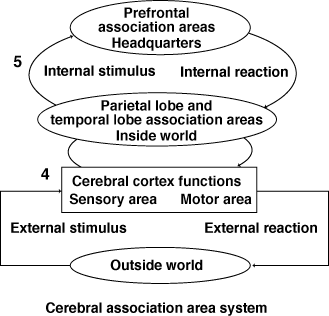
Fig. 9
It is generally said in the research of the brain that the brain receives outside stimuli, and then feeds the response back to the outside world. In fact, an internal world exists in the brain. Information is integrated in this internal world, and then an association area is created. This association area constitutes a world inside the internal world of the brain. Isolated from the outside world, internal world models can be made. The center for personality is located in the association area of the internal world model and the parietal lobe. What is being exchanged between the center for personality and the inside headquarters of the brain is "consciousness," or the "mind." This relationship is what this model explains to us. I think this mind model is quite effective.
A similar model appears in the book "The Self and its Brain" by Popper and John Eccles (Fig. 10). There are three worlds in this model: World 1, World 2, and World 3. World 1 is purely an outside world. World 2 is a conscious state. An internal world built inside the conscious state is World 3. In the brain, Worlds 1, 2 and 3 are created. The very origin of consciousness is the creation of a world model inside an internal world which has been created by sensory inputs directly connected with the outside world. The creation of such a world model is very important to intelligence.
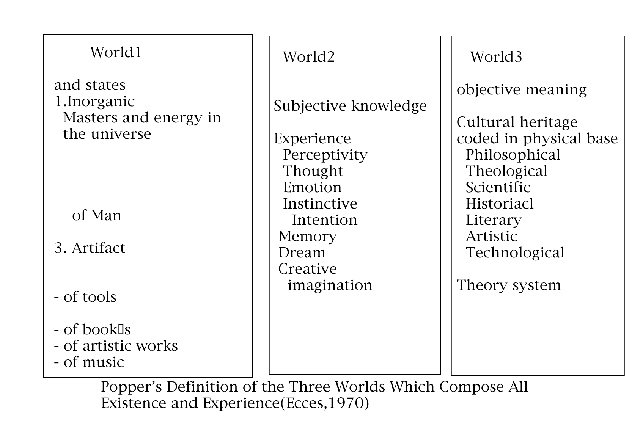
Fig. 10
In earlier studies of artificial intelligence, however, we lacked the understanding of consciousness that was necessary for further development of artificial intelligence. At that time, we just regarded artificial intelligence as a simple extension of information processing or signal processing. However, if artificial intelligence is so simple, why can't search engines for the Internet become smarter?
Search engines for the Internet are computer robots. They can energetically read millions of pages everyday. And once given a keyword, they dash to the heap of data to look for pages containing the keyword and retrieve them like a hunting dog. These search engines repeat that job everyday. If a person, a being of conscious existence, had to do the same job day after day, they would become progressively smarter. However, computer engines never become smarter. It's like trying to scoop up water with a strainer. They can have a lot of throughput, but no input. True intelligence cannot be formed in this way.
What is true intelligence then? First of all, an intellectual act must have a purpose. To achieve that purpose, an intention, or plan, is necessary. According to one's intention, information will be searched for and collected. Useful pieces of information will be picked up and arranged into various combinations, and then piled up on the existing body of knowledge. This represents the process of true intelligence. This process is a very intellectual and highly intentional task-oriented act. So, a purpose and an intention, or plan, are basically indispensable. The accumulation of intellectual information and knowledge cannot be made without them.
The Japanese Society for Artificial Intelligence commemorated its 10th anniversary last year. On that occasion, I delivered a lecture explaining that conventional research of artificial intelligence was based on the assumption that intelligence could be completed without considering intention. In other words, researchers believed that intelligence could become intelligent enough on its own, and that an artificial intelligence could be produced that way. It seems that this idea is based on Rene Descartes' proposition, "Je pense, donc je suis" (I think, therefore I am.) (Fig. 11).
Fig. 11
As the subject of my graduation essay, I selected Maine de Biran, a French philosopher scarcely known to the public. Biran argued that the very origin of "being" was not "thinking," but rather, "intending" or "desiring." He developed this proposition, "Je veux, donc je suis" (I intend, therefore I am.). Maine de Biran was an 18th- to 19th-century thinker, and lived in the days of the French Revolution. A current of thoughts generally called the "philosophy of life," which would later reach Henri Bergson, originated in this age. Throughout the history of European philosophy, there have always been thoughts which view the intellectual world voluntarily rather than intellectually. As I stated before, the idea that intelligence cannot be formed without intention is now being expressed in various forms, including cognitive science. The European tradition of thought serves as a background for this movement.
By further developing Biran's proposition we may say, "Je sens, donc je suis" (I sense, therefore I am) or "Je fais, donc je suis" (I do, therefore I am).
The existence of human beings is not composed of a simple structure but is like a world of multi-agents. We probe the human internal world and have gradually found it as in Marvin L. Minskey's "The Society of Mind." "Sensing," "doing," "thinking," and "intending" - all are totally different pillars. Without these pillars, human intelligence and comprehensive capabilities would not be possible. As a result of brain science research, we know that the human brain has many areas. This chart (Fig. 12) is an outcome of a thorough brain investigation and indicates how these pillars are interconnected in a topographical expression.
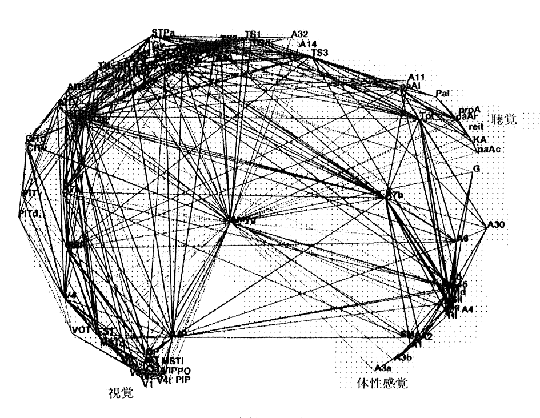
Fig. 12
If you take a close look at the chart, you will soon notice that there is a hub of various cerebral areas; this focal point is called "amygdala," the center of emotion. The fact that the amygdala forms a focal point means that "Je sens, donc je suis" can be---even though not perfectly---applied to human intelligence. If you try to create a system comparable to human intelligence and make it process information the way humans do, an element like an amygdala will be indispensable. Experimental efforts have already been made to integrate an "emotion syste" or "consciousness" into AI systems. In some research cases, systems with "emotion" or "consciousness" integrated work very well.
It is becoming clear that human intellectual acts begin with recognition and require the whole personality rather than any single part or area of the cerebrum, whatever process such acts will take.
In this sense, the "Affordance Theory" proposed by J. J. Gibson, is now attracting considerable attention in the field of cognitive science.
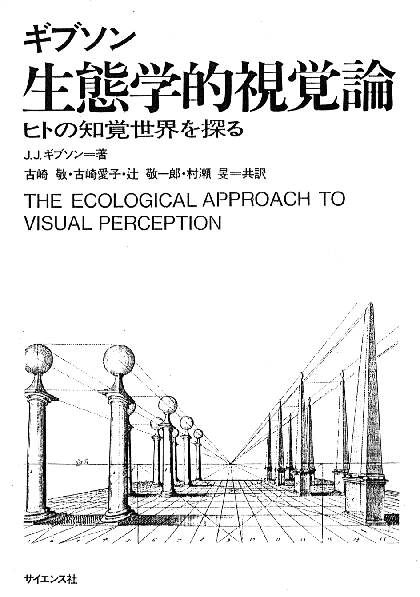
It is quite difficult to explain what affordance is. For a detailed explanation, I would like you to read some books by yourself since many publications about affordance are now available. What do all animals, including mankind, recognize when they recognize things? Although present artificial intelligence systems are modeled after the way people process and analyze information, other animals take different approaches towards recognition; that approach is affordance.
The word "affordance" was coined by J.J. Gibson, and is very hard to explain. In summary of his definitions, affordance is the set of concepts about all things that the environment offers or prepares for animals. When you recognize something, what the object of your recognition can afford you is of the utmost importance. Recognition is the sum total of what the object of recognition can afford the recognizing subject. In other words, recognition is not an analytical and comparative process at all.
Given the topic of recognition, I personally focus on "Ontology," which is recently raising its profile among artificial intelligence activities.
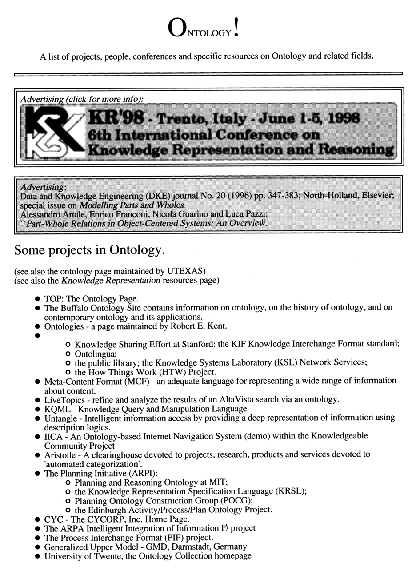
Fig. 14
If you are not a specialist, the concept of ontology may be new to you. Several papers were listed in the ontology category of the proceedings of last yearıs meeting of the Japanese Society for Artificial Intelligence. However, the number of research groups involved with ontology is still small. What is ontology? There are many Web sites for ontology available on the Internet (Fig. 15). If you access those ontology-related sites, you will soon understand that the concept of ontology is controversial and has yet to be completely established.
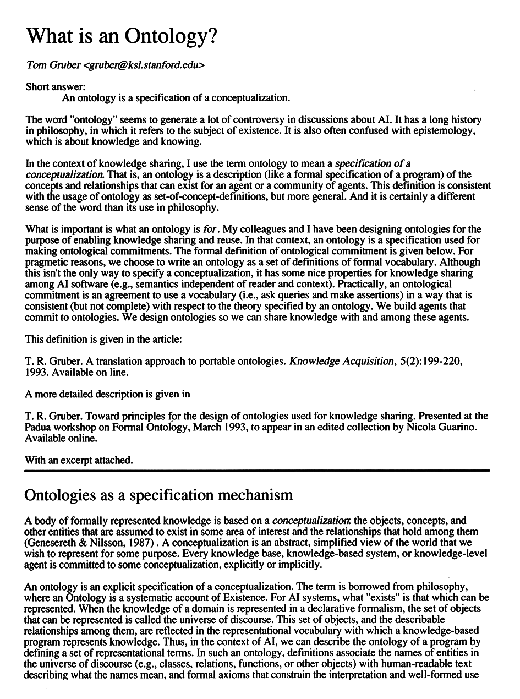
Fig. 15
Ontology is a very familiar concept to people who have a philosophical background like me. In Japanese, we call it "Sonzai-ron" (theory of being). Philosophy can be said to be a series of argument and disputes about the theory of being which have been continuing for centuries; ontology is one of philosophy's major subjects. Ontological arguments are philosophy, so this is a quite interesting field for me. At last yeay's meeting of the Japanese Society for Artificial Intelligence, I heard, for the first time, the use of this concept in the field of AI systems. I was surprised and wondered why the term "ontology" was being used in regards to this field. Since then, I have been studying "ontology" in AI research and have come to understand the reason.
Ontology is a "set of concept definitions." This particular "definition" of ontology refers to a world description (Fig. 16).
Fig. 16
When you describe a world using many concepts, ontology helps create consistency among those descriptive concepts. Such consistency can be established by understanding the relationships and meanings of all concepts as an entire network, and by clarifying their positions. This is a practice of thinking commonly used in philosophy.
The relationship between ontology and epistemology can be described as that
of the "heads and tails" of a coin. Once ontology is established, epistemology
can be effective. Reversely, "being," or ontology, can be discussed and world
can be described because epistemology is effective. They have such a sensitive
relationship.
So far, research of artificial intelligence has encountered
many difficulties. The hardest to overcome has been the problem of recognition.
The background of this difficulty lies in the fact that ontology was not
commonly accepted in the field of computer science. For the first time, we know
that computers will need ontology to recognize the outside world.
It is very difficult to briefly describe all the ontological theories employed in computer research. Some researchers handle everything in a conceptual world, and some regard ontology as a means of describing a world in which their autonomous mobile robots travel. Anyway, ontology will be a prerequisite when autonomous mobile robots attempt to recognize their surrounding world. With the help of ontology, robots can integrate incoming information from sensors. This perfectly overlaps J. J. Gibson's Affordance Theory. Human concepts are not useful in describing a world of robots, but robots need a description of the world as viewed from their own position. If one inquires as to what description these robots will require, the answer can be found within Gibson's Affordance Theory.
You probably use the term "real world" in a casual manner. In fact, the real world concept and ontology overlap each other. If it were not for ontology, we could not determine what the real world is. In this sense, we should try to think about what the real world is for insects before thinking what the real world is for human beings. The real world for insects is entirely different from the real world for human beings. This is exactly what the Affordance Theory argues. A total of what the environment can offer or afford a subject (living thing) is the necessary information for that particular subject. The subject must use its intelligence based on that information.
If ontology develops a kind of category error and deviates the course of research, what will happen? I know a popular joke. One day, an AI researcher found that ants were marching in very complicated patterns. He wondered what wonderful algorithm was behind the ant walking patterns. He thought really hard and f inally found the answer. Ants were simply choosing the lowest places of the ground undulation to avoid clmbing stress. The real world always appears in the form of the "real world for a subject."
The real world for a certain subject means a total of what the environment can offer or afford the subject. This idea follows the thought patterns of ontological descriptions and the "Affordance Theory." The world described through ontology is a world model which constitutes the foundation of consciousness. Therefore, world description is a world model. Consciousness, ontology, and the real world are inseparable from each other.
In conclusion, a model of the world produces consciousness. (Fig. 17).
Fig. 17
There must be a moment when consciousness is first formed - the "emergence" of consciousness in the context of evolution history. As with the case of the "consciousness chip" inserted in the snake robot, a world model is created and simulation is conducted in it. Many people have written that the very beginning of consciousness is when you create a world model, project yourself objectively into the model, and move the projected self in your imagination.
At present, machines or computers have already reached that level. If we could further develop such a world model through genetic algorithms, for instance, the world model could start evolving, and the evolution of its consciousness could be achieved at an astonishingly high speed, because electronic evolution can be much faster than biological evolution. Then, super-intelligent computers like HAL 9000 could emerge in the long run.
If so, we will face another big problem. If you remember the end of HAL 9000 in the film "2001: A Space Odyssey," it wasn't a perfectly happy story. The computer finally rebelled against the human crew of the spaceship because he had his own consciousness with an intention quite apart from, or even opposite to, the intentions of the human astronauts (Fig. 18).
Fig. 18
If the evolution of computers continues, problems which have only been possible in fiction might actually happen. Considering the potential for extremely high speed electronic evolution once the help of genetic algorithms takes place, we must start discussing how to deal with those fictitious problems at an early stage, I'm afraid.
A psychologist, H. W. Nissen, prepared a chart of intelligence development in phylogeny, the biological history from lower animals to mankind (Fig. 19).
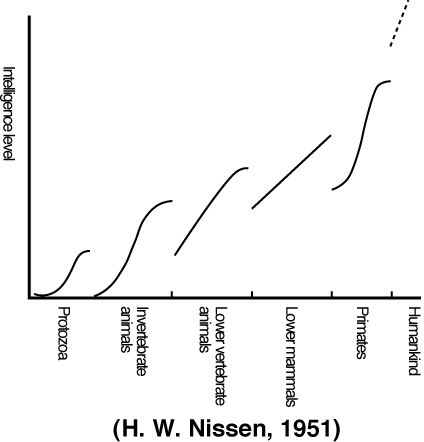
Fig. 19
Intelligence levels listed in the chart are not objective but measured by Nissen's own scale. On the whole, the levels improved according to biological evolution. The intelligence levels of other creatures up to the primate are expressed in solid lines while human levels are expressed by a broken line, because human intelligence is not yet thoroughly understood.
Human beings have invented computers and artificial intelligence systems and are integrating them in their society. As a result, a hybrid intelligent society of human beings and computers is now being developed. When we measure human intelligence levels, therefore, we must take into account the levels of AI systems that we personally or socially use, in addition to the intelligence that we possess by nature. Mankind is now standing on the edge of an entirely new stage of evolution.
There are many ways to improve the intelligence level of computers. The point is that we have now reached a crucial milestone, and we must deliberate present and future problems that we may face, including the problems symbolic of HAL 9000, and advance our intelligence level high enough to solve these actual and potential problems.
I believe that the Real World Computing Project should be highly evaluated since it has taken a great step forward in that direction.